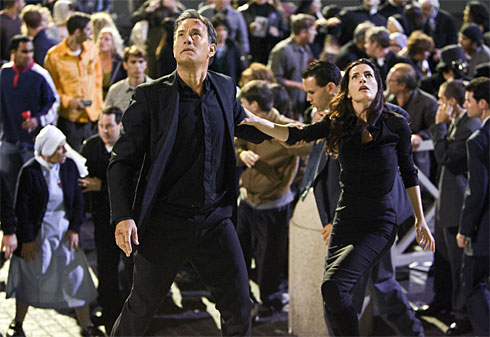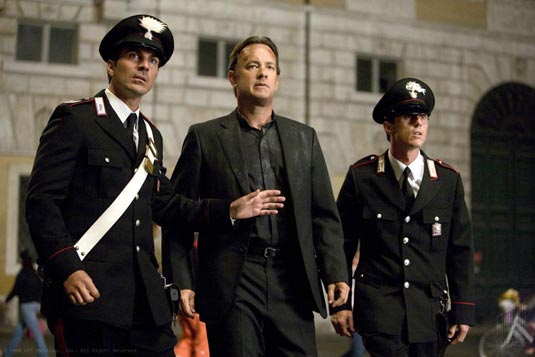Angels & Demons (2009)
DIRECTOR: Ron Howard
CAST:
Tom Hanks, Ewan McGregor, Ayelet Zurer, Stellan Skarsgard, Pierfrancesco Favino, Armin Mueller-Stahl, Nikolaj Lie Kaas, Thure Lindhardt
REVIEW:
While Dan Brown’s novel Angels & Demons chronologically took place before The Da Vinci Code, the movie is a sequel to the 2006 Ron Howard-Tom Hanks film. In the wake of scathing reviews dissmissing the first as leaden and ploddingly-paced (which I did not, for the most part, agree with), Howard obviously took a few steps here to make Angels & Demons more conventionally cinematic, but despite a faster, somewhat more action-oriented pace, Angels & Demons is a close cousin to its predecessor, and whether that is a good thing or a bad thing will largely depend on your opinion of The Da Vinci Code.
 In the wake of the Pope’s death, the Prefertiri (the four Cardinals considered the favorites to succeed him) have been kidnapped by shadowy conspirators claiming to represent the Illuminati, a secret society of scientific thinkers seeking revenge against the Vatican for past persecutions, who announce the Cardinals will be murdered in public locations at the stroke of eight, nine, ten, and eleven o’clock. And then at midnight will come the final revenge…the battery will run down on a canister of stolen anti-matter hidden somewhere in Rome, resulting in the complete destruction of Vatican City. Though not without misgivings over his teachings and views, the Vatican turns in desperation to Harvard symbologist Robert Langdon (Tom Hanks), hoping his expertise in deciphering ancient symbols can help figure out the clues in the conspirators’ video and locate the four cardinals and the anti-matter. Helping Langdon is an Italian scientist, Vittoria Vetra (Israeli actress Ayelet Zurer), an Italian policeman, Inspector Olivetti (Pierfrancesco Favino), and the Camerlengo (in Vatican terminology, the Pope’s chamberlain and the interim officeholder in the time period between the Pope’s death and the election of a successor) Patrick McKenna (Ewan McGregor).
In the wake of the Pope’s death, the Prefertiri (the four Cardinals considered the favorites to succeed him) have been kidnapped by shadowy conspirators claiming to represent the Illuminati, a secret society of scientific thinkers seeking revenge against the Vatican for past persecutions, who announce the Cardinals will be murdered in public locations at the stroke of eight, nine, ten, and eleven o’clock. And then at midnight will come the final revenge…the battery will run down on a canister of stolen anti-matter hidden somewhere in Rome, resulting in the complete destruction of Vatican City. Though not without misgivings over his teachings and views, the Vatican turns in desperation to Harvard symbologist Robert Langdon (Tom Hanks), hoping his expertise in deciphering ancient symbols can help figure out the clues in the conspirators’ video and locate the four cardinals and the anti-matter. Helping Langdon is an Italian scientist, Vittoria Vetra (Israeli actress Ayelet Zurer), an Italian policeman, Inspector Olivetti (Pierfrancesco Favino), and the Camerlengo (in Vatican terminology, the Pope’s chamberlain and the interim officeholder in the time period between the Pope’s death and the election of a successor) Patrick McKenna (Ewan McGregor).
While The Da Vinci Code had no less than the theorized bloodline of Jesus Christ at its core, Angels & Demons doesn’t boast any such major historical revelation, but while The Da Vinci Code moved slowly (some felt too slowly), Angels & Demons‘ pace is kicked up by the race against time, which injects more suspense and tension, especially as the clock approaches the date of each Cardinal’s execution and draws closer to the scheduled explosion. Ron Howard doesn’t throw in the touch of Langdon’s mental visualization of the clues he uncovered as in The Da Vinci Code, but as in the first film, he keeps the movie consistently looking good, the camera passing lovingly over ancient statues, St. Peter’s Square and the Basilica, and the massive corridors and ornate rooms of the Vatican (the Vatican interiors impressively rendered on sets, as the Vatican did not allow Howard to film within its walls). And there’s still a lot of talky scenes of Langdon rattling off information about ancient symbols and using hidden codes in books, sculptures, and paintings to form a trail leading to the Cardinals and the anti-matter. If you found the very similar scenes in The Da Vinci Code interminable, you’re likely to find Angels & Demons frustrating, but I find this kind of stuff fascinating, so it works for me. To me, the inherent fun of stuff like this is simple: it’s like a treasure hunt. As they did with The Da Vinci Code, the Catholic League (represented by its belligerent spokesman, William Donohue, who invariably seems to be ranting furiously about something) urged boycotts of the movie, accusing both Dan Brown and Ron Howard of anti-Catholic propaganda, but the general Catholic backlash was not as severe as for The Da Vinci Code. Angels & Demons doesn’t contain any plot element as controversial as The Da Vinci Code‘s claims about Jesus’ possible marriage to Mary Magdalene, and while its depiction of some Vatican characters is less than flattering, and it touches on past church campaigns of extermination against dissenting scientists, it does not overall seem to be particularly anti-Catholic or anti-Vatican. There is the obstructionist Commander Richter (Stellan Skarsgard), head of the Swiss Guard, the Pope’s personal bodyguard, who plainly doesn’t think Langdon has any business poking around the Vatican, and Cardinal Strauss (Armin Mueller-Stahl), who seems more concerned with rules, ceremony, and maintaining an unflappable public appearance than evacuating the Vatican for public safety, but McGregor’s McKenna comes across as a reasonable and intelligent priest whose unwavering faith does not blind him to common sense. As in The Da Vinci Code, some of the plot doesn’t hold up to scrutiny (in particular, the true story of the Illuminati is rather less dramatic than what the movie makes out, the anti-matter seems like a plot element borrowed from the latest Star Trek of all things, and shouldn’t a Harvard expert in ancient symbols like Langdon be able to read Italian and Latin without continually asking for help translating?), but the movie does an effective job of behaving as though it takes itself seriously within its own context.
 Robert Langdon won’t go down as one of Tom Hanks’ most memorable roles, in either of his appearances in the part, and it’s clear Hanks is not tremendously invested in the material (understandably so, given it doesn’t give him a lot to grab onto besides a nice paycheck). Hanks does the bare minimum required of him; show up, be a familiar amiable presence we don’t mind following as our guide into the convoluted treasure hunt, and scurry around rattling off encyclopedic levels of exposition. Ayelet Zurer is basically a stand-in for the previous installment’s Audrey Tautou, but is a much less fleshed-out character, serving no real purpose besides being a reasonably attractive female sidekick to follow Langdon around and give him someone to rattle off his wealth of information to. Ewan McGregor’s soft-spoken McKenna gives us an all-too-rare figure inside the movie’s Vatican who doesn’t put rules and appearances above common sense, while Stellan Skarsgard and Armin Mueller-Stahl do effective jobs as the kinds of characters who may or may not have ulterior motives for their uncooperative attitudes; Skarsgard is suitably ominous as the cliched obstructionist police official who treats Langdon with disdain at every turn and tolerates his presence as grudgingly as possible, while Mueller-Stahl hovers around in dark hallways and is perhaps a little too obviously meant to be viewed as suspicious. Nikolaj Lie Kaas’ kidnapper/assassin comes across as a less fleshed-out and less interesting stand-in for Paul Bettany’s Silas in The Da Vinci Code much as Ayelet Zurer does for Audrey Tautou, and Thure Lindhardt, who lost the role of Silas to Bettany, has a supporting role here as a member of the Swiss Guard. Ron Howard’s father Rance Howard makes a cameo as a Cardinal.
Robert Langdon won’t go down as one of Tom Hanks’ most memorable roles, in either of his appearances in the part, and it’s clear Hanks is not tremendously invested in the material (understandably so, given it doesn’t give him a lot to grab onto besides a nice paycheck). Hanks does the bare minimum required of him; show up, be a familiar amiable presence we don’t mind following as our guide into the convoluted treasure hunt, and scurry around rattling off encyclopedic levels of exposition. Ayelet Zurer is basically a stand-in for the previous installment’s Audrey Tautou, but is a much less fleshed-out character, serving no real purpose besides being a reasonably attractive female sidekick to follow Langdon around and give him someone to rattle off his wealth of information to. Ewan McGregor’s soft-spoken McKenna gives us an all-too-rare figure inside the movie’s Vatican who doesn’t put rules and appearances above common sense, while Stellan Skarsgard and Armin Mueller-Stahl do effective jobs as the kinds of characters who may or may not have ulterior motives for their uncooperative attitudes; Skarsgard is suitably ominous as the cliched obstructionist police official who treats Langdon with disdain at every turn and tolerates his presence as grudgingly as possible, while Mueller-Stahl hovers around in dark hallways and is perhaps a little too obviously meant to be viewed as suspicious. Nikolaj Lie Kaas’ kidnapper/assassin comes across as a less fleshed-out and less interesting stand-in for Paul Bettany’s Silas in The Da Vinci Code much as Ayelet Zurer does for Audrey Tautou, and Thure Lindhardt, who lost the role of Silas to Bettany, has a supporting role here as a member of the Swiss Guard. Ron Howard’s father Rance Howard makes a cameo as a Cardinal.
My feelings are that those who enjoyed Robert Langdon’s first adventure should enjoy his second. Some will be disappointed by the way Angels & Demons puts more emphasis on action, while others will welcome it. The treasure hunt aspect is still well intact, with a race against time to give it an extra oomph. As in The Da Vinci Code, there is a surprise twist (albeit as in the earlier film, doing a process of elimination, weeding out the obviously suspicious characters and seeing who remains, should give you a pretty good guess at the ‘surprise villain’). Be warned that there are a couple of scenes as or more disturbing than Paul Bettany’s self-abuse in The Da Vinci Code. Dan Brown’s books are page-turning pulp that are unapologetically a little preposterous and weave fact, myth, and outright fiction, but Angels & Demons captures a lot of the reason they’re best-sellers. The movie isn’t great filmmaking, but it’s compulsively entertaining filmmaking.
***